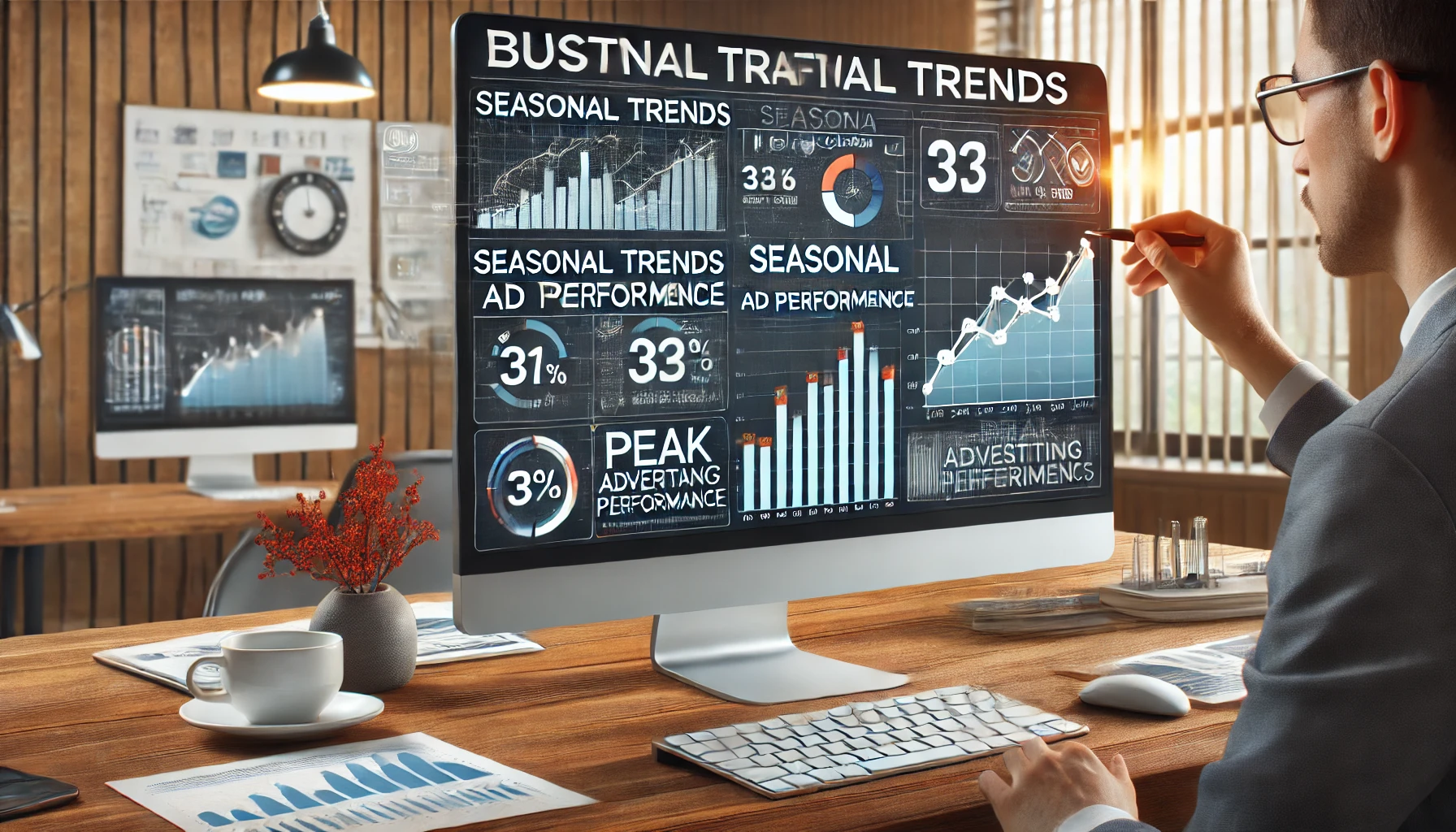Seasonal trends have a significant impact on consumer behavior, and smart advertisers use them to boost engagement, drive more sales, and maximize ROI.
By aligning paid traffic campaigns with holidays, sales periods, and seasonal events, businesses can take advantage of increased demand and stand out from competitors.
In this guide, you’ll learn how to use seasonal trends to improve paid traffic campaigns and drive better results.
1. Why Seasonal Trends Matter in Paid Advertising
📌 How Seasonal Trends Affect Paid Traffic Campaigns:
✔ Increased Consumer Demand – People are more likely to buy during holidays and peak seasons.
✔ Higher Ad Competition – More businesses run ads, increasing cost-per-click (CPC).
✔ Short-Term Sales Opportunities – Limited-time offers create urgency and FOMO (Fear of Missing Out).
✔ Changes in Audience Behavior – Some seasons drive higher engagement than others.
💡 Pro Tip: Running ads without considering seasonal trends can lead to higher ad costs and missed revenue opportunities.
2. Identify the Most Important Seasonal Trends for Your Business
Not all seasonal trends apply to every business. Identify the ones that align with your products, services, and target audience.
📌 Key Seasonal Trends & Sales Events to Leverage:
| Seasonal Event | Best For | Key Dates |
|---|---|---|
| New Year Promotions | Fitness, self-improvement, personal finance | January 1st – January 15th |
| Valentine’s Day | Jewelry, flowers, chocolates, gifts | February 14th |
| Spring Sales | Home decor, fashion, travel | March – May |
| Back-to-School | Clothing, electronics, school supplies | July – September |
| Halloween | Costumes, decorations, themed products | October 31st |
| Black Friday & Cyber Monday | All industries (biggest shopping days) | Last Friday of November & Monday after |
| Christmas & Holiday Shopping | Gifts, winter fashion, electronics | December |
💡 Pro Tip: Plan seasonal campaigns at least 4-6 weeks in advance to stay ahead of competitors.
3. Research Consumer Behavior & Adjust Your Strategy
📌 How to Find Seasonal Trends in Your Industry:
✔ Google Trends → Search for seasonal keyword trends.
✔ Google Analytics → Check past traffic spikes & conversion trends.
✔ Facebook Audience Insights → See how consumer interests change over time.
✔ Amazon & eBay Sales Data → Identify peak sales periods for different products.
💡 Pro Tip: If your business has been running for more than a year, analyze last year’s ad performance to predict this year’s seasonal trends.
4. Adjust Paid Traffic Budgets Based on Seasonality
📌 How to Allocate Budget for Seasonal Campaigns:
✔ Increase Ad Spend During Peak Demand – Boost budgets 2-5x during high-traffic seasons.
✔ Reduce Spend in Low-Demand Months – Lower budgets when consumer interest drops.
✔ Set Up Automated Bidding Strategies – Use Target ROAS or Maximize Conversions to optimize spend.
✔ Use Dayparting – Show ads only during high-converting hours to save budget.
💡 Pro Tip: Some industries see CPC increase by 30-50% during seasonal sales—plan accordingly.
5. Create Seasonal Ad Creatives for Higher Engagement
Consumers engage more with ads that match the season. Refresh your creatives to stay relevant and eye-catching.
📌 Best Practices for Seasonal Ad Creatives:
✔ Use Seasonal Colors & Visuals → Add Christmas themes, summer vibes, or holiday graphics.
✔ Incorporate Holiday Messaging → Example: “Get the Perfect Valentine’s Gift!”.
✔ Emphasize Time-Sensitive Offers → “Limited-Time Black Friday Deal – 24 Hours Only!”.
✔ Feature Seasonal Product Bundles → Promote gift sets, holiday packs, or event-specific discounts.
💡 Pro Tip: Update ad creatives, landing pages, and product descriptions to match the seasonal theme.
6. Optimize Landing Pages for Seasonal Conversions
📌 How to Make Landing Pages Seasonal & High-Converting:
✔ Use Seasonal Headlines & Banners → Example: “Spring Cleaning Sale – Save 30% Today!”.
✔ Add Countdown Timers → Creates urgency and boosts conversion rates.
✔ Feature Limited-Time Offers → Highlight seasonal discounts & holiday bundles.
✔ Optimize for Mobile Users → Over 70% of seasonal shoppers use mobile devices.
💡 Pro Tip: Use heatmaps (Hotjar, Microsoft Clarity) to analyze user behavior and optimize landing pages.
7. Use Retargeting to Capture Seasonal Shoppers
Many users don’t buy immediately—retargeting helps bring them back before the seasonal event ends.
📌 Best Retargeting Strategies for Seasonal Campaigns:
✔ Abandoned Cart Retargeting → Remind users to complete purchases before the sale ends.
✔ Engaged User Retargeting → Show ads to people who interacted with your holiday content.
✔ Email List Retargeting → Promote exclusive seasonal deals to past customers.
✔ Dynamic Product Ads → Display personalized product recommendations based on past behavior.
💡 Pro Tip: Retargeting often has the highest ROAS—allocate at least 30% of the seasonal ad budget to it.
8. Test & Optimize Ads Throughout the Season
📌 How to Monitor & Optimize Seasonal Ad Performance:
✔ Track CPC & CTR → If CPC increases too much, adjust targeting.
✔ A/B Test Different Creatives → Test new ad images, headlines, and CTAs.
✔ Monitor ROAS → Increase budgets on high-performing campaigns.
✔ Adjust Based on Competitor Activity → Check what competitors are running and adjust messaging accordingly.
💡 Pro Tip: Run real-time performance checks and adjust budgets daily during peak seasons.
9. Scale Winning Campaigns & Expand to New Audiences
📌 How to Scale Seasonal Ad Campaigns:
✔ Expand to Lookalike Audiences → Reach new buyers similar to existing customers.
✔ Increase Budget on High-Converting Ads → Scale top-performing campaigns first.
✔ Expand to Additional Platforms → If Facebook Ads are performing well, test Google, YouTube, or TikTok Ads.
✔ Use Cross-Promotion → Promote deals via email marketing & influencer collaborations.
💡 Pro Tip: If demand is higher than expected, increase budgets by 20-30% every few days.
Final Thoughts: Boosting Paid Traffic with Seasonal Trends
Seasonal marketing is one of the best ways to increase sales and engagement in paid ad campaigns. The key is planning ahead, adjusting budgets, and optimizing creatives to match consumer behavior.
📌 Key Takeaways:
✅ Identify seasonal trends that fit your business.
✅ Increase ad spend during peak sales periods.
✅ Update ad creatives & landing pages for seasonal appeal.
✅ Use retargeting to capture seasonal shoppers.
✅ Track & optimize campaigns throughout the season.
✅ Scale high-performing campaigns by expanding to new audiences & platforms.
🚀 Now it’s your turn! Start planning your next seasonal ad campaign and maximize your results!




